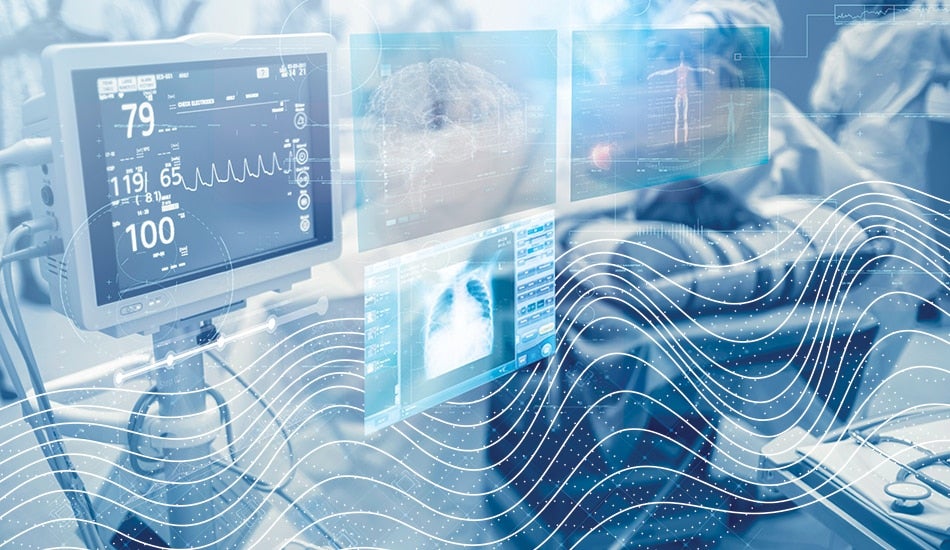
In early days of the COVID-19 pandemic, travel bans, physical lockdowns, heightened consumer demand, and supply chain disruptions challenged manufacturers in every industry. These unprecedented circumstances forced businesses to innovate in the moment, while rethinking almost every aspect of their operations to be more resilient at every phase of the product lifecycle: from ideation to production and beyond.
In this series, Flex manufacturing and supply chain experts will share solutions and unique insights into common hurdles—or “sticking points”— that can slow down or halt businesses. Subscribe to receive future installments and other Flex updates in our newsletter.

Resilient product design in a constantly changing world
The last few years have exposed vulnerabilities in every industry’s ability to get products to market. This has especially been the case in healthcare, where businesses, providers, and consumers were all impacted. We have also seen the industry act with speed and resiliency, accelerating innovation and transforming healthcare delivery and patient care to meet the demands of a global population. The lessons that our industry learned from the pandemic can easily be applied across industries and steps in the product lifecycle—from the product design phase all the way through to end-of-life.
Fighting a pandemic requires fast innovation, optimized speed-to-market, and scalability. But the healthcare sector has historically tended to operate within a well-established playbook. This has kept the system running smoothly in normal circumstances, but there is little room for deviation in the highly complex ecosystem of medical device and healthcare equipment ideation, manufacturing, and delivery. Put simply, the status quo made it very difficult to pivot when things went wrong.
Having spent my entire career in medical device development, I have witnessed the industry’s standard product design and engineering process firsthand. Medical equipment and devices are designed as iterations of previous versions. Due to rigorous testing and regulatory requirements, it is not unusual for it to take seven to 10 years to get a device onto the market. And in my experience, the healthcare industry can be insular due to intellectual property and other privacy considerations, meaning that robust cross-industry knowledge and supplier ecosystem collaboration are seen as the exception and not the norm.
This is all changing.
We can attribute part of this shift to the pandemic, which proved that the healthcare sector can become more agile in response to the critical needs of a global population. The other catalyst has been the blurring of the separation between medical and consumer devices for patient care and drug delivery, which means that the healthcare sector can no longer operate within a silo.
Today’s consumers want visibility and control of their own health beyond traditional care settings. Consider the ubiquity of fitness tracking and heartrate monitors, which are now integrated into wearable consumer electronics, or the increasing popularity of home health and telemedicine offerings.
Healthcare companies—alongside all businesses seeking to remain competitive—must reset their playbooks to become more resilient in the face of unforeseen challenges and to be prepared for a more connected and digital world.
Future-proofing device components, materials, and processes
In product design, future-proofing involves designing a product to minimize technical obsolescence and other impacts of future risks. This exercise is now a crucial one for product designers in every industry, who must adopt a broader point of view and consider everything from electronic component and material availability, new technologies and techniques, cross-industry learnings, future regulatory compliance needs, and sustainability goals.
Instead of defaulting to iterative designs that rely on legacy electronics, healthcare grade plastics, and other materials, designers must prioritize standard or widely available components to avoid future supply chain issues. When possible, products should be designed with redundancy in validated and certified components that can be accessed through a localized supply chain if needed.
In addition to availability of materials, it is important to consider parts count and component durability. Fewer overall parts mean a lower risk of supply chain impacts (if there are built-in redundancies). And using more robust components that are easily maintained comes with enormous benefits. For example, if a medical device at a hospital breaks down, it can be costly to send a specialized technician to repair it. By designing for durability and ease of maintenance, a company can expect to spend less on field calls while also providing a simple pathway for the customer to repair the device themselves. Additionally, products that are built to last are more sustainable, and some healthcare products provide aftermarket opportunities to maximize value through reuse and refurbishment.
In the healthcare industry, intensive testing is a baseline expectation in the process because products must be safe, compliant, and effective. However, advanced technologies now make it possible to speed the process while maintaining the same high standards and level of rigor. Recently, regulatory bodies have begun accepting some modelling and simulation to substitute for patient trials.
In the manufacturing process, digital twin technology is also proving to be a game changer.
By creating a real-time digital twin—or virtual representation—of the entire manufacturing process, design teams can change variables and observe outcomes faster than they could with a physical prototype alone. This leads to reductions in costs and schedules, optimized processes, and the ability to iterate on designs more effectively and efficiently.
For example, recently at Flex, we created a digital twin to accelerate and optimize development of one customer’s Class II diabetes product. The technology made it possible for us to test various scenarios and complete our optimization analysis in only three weeks, a process that would have otherwise taken over three months.
Harnessing cross-industry and cross-technological expertise
Healthcare customers also benefit from partnering with a manufacturer that is able to draw from a broader range of capabilities and perspectives across very different industries. The ability to apply learnings from faster-turn industries—like consumer electronics or home appliances—and to apply best practices, technologies, and processes to address healthcare sector needs become a key differentiator.
Fostering a culture in which designers and engineers are encouraged to learn from other industries and stay abreast of emerging technologies improves adaptability and opens the door to greater design innovation. To address the evolution of medical devices and healthcare equipment becoming consumer devices requires an understanding of connectivity, smart devices, Internet of Medical Things (IoMT), and nascent technologies from other industries.
Being ready for future regulatory requirements
None of us can predict the future, but we do know that regulations will continue to grow and change as innovations are introduced into the medical devices and healthcare solutions space.
It’s clear that with the rapid introduction of new technologies, it may take time for regulatory bodies to catch up and establish directions and requirements. When designing with new technologies, companies must think through the possible repercussions and risks, within the context of the opportunities ahead. For example, the ubiquity of connected devices enabled through the cloud and 5G is making healthcare more accessible and affordable. But this often leaves patients, providers, and hospitals vulnerable to cyber-attacks. Engineers must address this reality and ensure the safety and security of products and patient data.
Where do we go from here?
The pandemic stress-tested all industries and taught us to think differently in seeking to build resilience into the entire product lifecycle. For many companies and regulatory bodies, it was a motivating call to develop a more agile approach. For those of us who work in product design, it also exposed the need to prioritize future-proofing to become faster, more innovative, and more resilient. If we do not consider resiliency in the product design phase, we run into the risk of being blindsided further down the road.
On the healthcare front, I remain excited to be working in the industry at such a critical time and partnering with other sectors to help influence the next wave of medical devices and healthcare equipment. From wearable electronics that combine medical technology and consumer electronics, to more predictive systems that tap into the capabilities of artificial intelligence and machine learning, I anticipate a great deal of cross-industry collaboration in the future.
If we are willing to openly share ideas, think expansively, and take the steps needed to optimize innovation and manufacturing, what was only imaginable previously will become a reality in healthcare and beyond.



